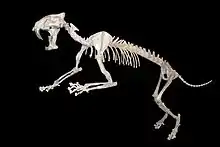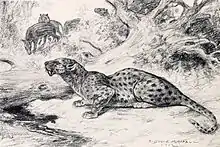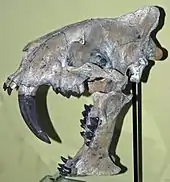Hoplophoneus
Hoplophoneus is an extinct genus of the family Nimravidae, endemic to North America during the Late Eocene to Early Oligocene epochs (35-29 mya), existing for approximately 6 million years.[1]
| Hoplophoneus | |
|---|---|
 | |
| H. primaevus skeleton, Zurich natural history museum | |
| Scientific classification | |
| Kingdom: | Animalia |
| Phylum: | Chordata |
| Class: | Mammalia |
| Order: | Carnivora |
| Suborder: | Feliformia |
| Family: | †Nimravidae |
| Subfamily: | †Hoplophoninae |
| Genus: | †Hoplophoneus Cope, 1874 |
| Species | |
| |
| Synonyms | |
| |
Taxonomy


In 2016, all North American species of Eusmilus were placed in Hoplophoneus by Paul Z. Barrett.[2]
Description
Hoplophoneus, though not a true cat, was similar to cats in outward appearance, though with a robust body and shorter legs. The largest known specimen was examined by Sorkin (2008) for body mass and was estimated to have a weight of 160 kg (350 lb).[3]
Hoplophoneus occidentalis was about the size of a large leopard and had canine teeth of only moderately-larger size. The larger H. sicarius and H. mentalis had very large upper canines and a massive flange at the front of the lower jaw.[4]
Pathology
An adult specimen of Hoplophoneus discovered in Badlands National Park, South Dakota, in 2010 by paleontologist Clint Boyd et al. was found to have bite marks on its skull from the teeth of another adult individual of Hoplophoneus. From examination of the wounds, it was found that the animal had been wounded by its rival's saber-teeth. Regrowth of bone around the injuries shows that the nimravid survived the attack. Similar finds also reveal that such fights were likely commonplace among nimravids and that they would often aim for the back of the skulls and eyes of their opponents.[5]
References
- Turner, Alan. National Geographic Prehistoric Mammals. National Geographic, 2004., pp.120-121
- Barrett PZ. (2016) Taxonomic and systematic revisions to the North American Nimravidae (Mammalia, Carnivora) PeerJ 4:e1658 https://doi.org/10.7717/peerj.1658
- Sorkin, B. (2008-04-10). "A biomechanical constraint on body mass in terrestrial mammalian predators". Lethaia. 41 (4): 333–347. doi:10.1111/j.1502-3931.2007.00091.x.
- Turner, Alan (1997). The Big Cats and their Fossil Relatives: an illustrated guide. New York: Columbia University Press. pp. 234. ISBN 978-0-231-10228-5.
- The Dakota Badlands Used to Host Sabertoothed Pseudo-Cat Battles
| Wikispecies has information related to Hoplophoneus. |